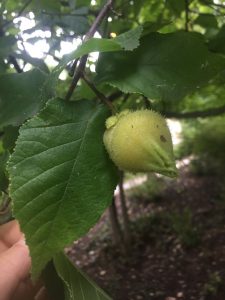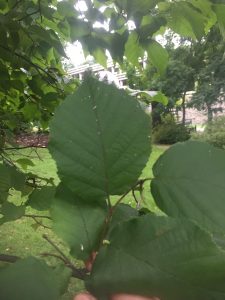(Corylus Americana)

Description
The American Filbert, or American Hazelnut, is a medium to large shrub growing from 2-5 meters tall. The leaves are oval, coming to a point at the tip, and mildly serrate, arranged oppositely along the stem. In the fall, male catkins (fuzzy, cylindrical, pollen-producing structures) are produced and remain on the plant until early spring, when the smaller female catkins emerge. Fertilized female catkins produce a nut encased in a sheath (called a bract), that ripen in late summer to fall.

Cultivation Tips
American filbert is not picky about soil type, but prefers good drainage. Although it will grow in partial shade, production will be greatest in full sun. If you find a specimen producing well in shade, be sure to save the nuts to further cultivate that variety. Once established, hazelnuts are very hardy, withstanding harsh weather and heavy pruning [63]. They can be pruned to a range of shapes, from very wide and bushy to tall and slim, sometimes looking like a small tree. Hazelnuts require sufficient nitrogen, so be sure to companion plant with nitrogen fixers. They are also subject to deer browse when small and squirrels who like to bury their nuts at the base of the plant, so be sure to design around that as well.
Uses
American Filberts can provide an abundance of high-quality nuts for cooking, baking, making oils and nut butters, or just eating plain. The plant also provides cover for birds, and many species rely on the male catkins for food in winter when few other food sources are available. Filberts, if pruned to be bushy, make a great addition to a windbreak or hedgerow, helping to regulate microclimate throughout the garden.
Friends
Clover for nitrogen. Anise hyssop for deer protection. Garlic/onion for squirrel protection.